#b2
Volkswagen Passat Passes Away
The final Volkswagen Passat has rolled off the assembly line in Chattanooga, Tennessee, ending the model’s extended run on the North American market.
Designed by Giorgetto Giugiaro and introduced in 1973 using the VW/Audi B1 platform, the Passat arrived in the United States as the Dasher and was sold as a midsized luxury vehicle to people in the market for an imported economy car. The model carried different names in other parts of the world and even saw a few unique monikers used in the U.S. (e.g. Quantum) to help differentiate between the hatchback, sedan, and wagon variants sold throughout the 1980s. But it was officially known as the (B2) Passat by 1990, regardless of format.
Crapwagon Outtake: 1986 Volkswagen Quantum Syncro Wagon
Since September, the collective wisdom of the Internet has changed. Before, the ideal car — as decreed by keyboard warriors across this great nation — was an all-wheel drive, manual, diesel wagon. Now, however, oil burners are less popular than even Jeb Bush.
Today’s feature checks all three remaining post-Dieselgate fanboy boxes.














Recent Comments